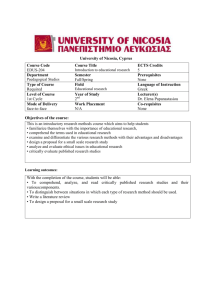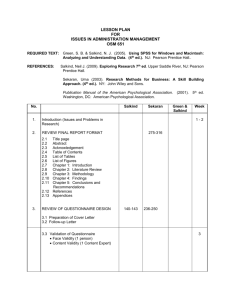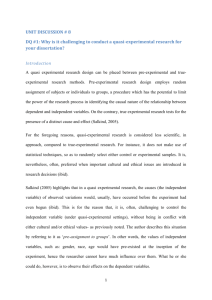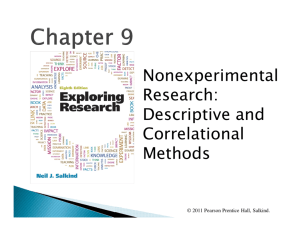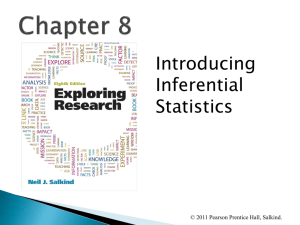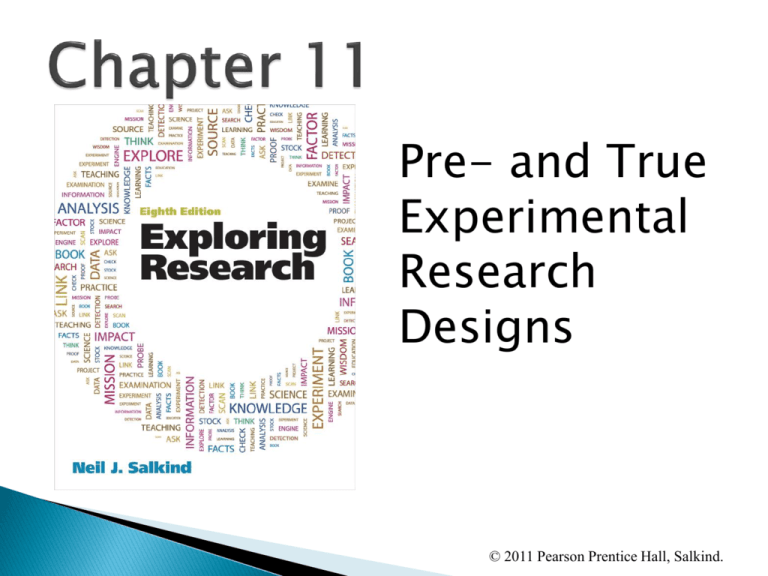
Pre- and True
Experimental
Research
Designs
© 2011 Pearson Prentice Hall, Salkind.
Explain why experimental designs are so
important.
Identify and summarize examples of preexperimental and true experimental designs.
Discuss the major difference between preexperimental and true experimental designs
and how this impacts the ability to determine
causality.
Discuss the importance of randomization to
the experimental design.
© 2011 Pearson Prentice Hall, Salkind.
Distinguish between internal and external
validity in research design.
List and provide examples of the threats to
internal validity.
List and explain the threats to external
validity.
Discuss how researchers control for
extraneous variables.
© 2011 Pearson Prentice Hall, Salkind.
Experimental Designs
Internal and External Validity and
Experimental Design
Controlling Extraneous Variables
© 2011 Pearson Prentice Hall, Salkind.
© 2011 Pearson Prentice Hall, Salkind.
Allow statements about cause and effect
◦ By controlling potential sources of variance
The simplest experimental design
◦ Randomly selects subjects from population
◦ Experimental group—receives treatment
◦ Control group—does not receive treatment
© 2011 Pearson Prentice Hall, Salkind.
PreExperimental
Design
True
Experimental
Design
QuasiExperimental
Design
Presence of a control
group?
In some cases,
but usually not
Always
Often
Random selection of
subjects from a
population?
No
Yes
No
Random assignment
of subjects to
groups?
No
Yes
No
Random assignment
of treatments to
groups?
No
Yes
No
None
Yes
Some
Degree of control
over extraneous
variables?
© 2011 Pearson Prentice Hall, Salkind.
Participants are assigned to one group
Treatment
Post-Test
◦ No randomization
© 2011 Pearson Prentice Hall, Salkind.
Compare same subjects before and after treatment
Participants are assigned to one group
Pretest
Treatment
PostTest
– No randomization
– No control group
• Little ability to infer cause and effect
© 2011 Pearson Prentice Hall, Salkind.
Characteristics
◦ Random assignment
◦ Control group
Three typical designs
◦ Pretest post-test control group design
◦ Post-test only control group design
◦ Solomon four-group design
© 2011 Pearson Prentice Hall, Salkind.
Random Assignment of
Participants to Control Group
Pretest No Treatment
Post-test
Random Assignment of
Participants to Experimental or
Treatment Group
Pretest
Post-test
Treatment
Groups should be equivalent at beginning
SO
Observed differences must result from
treatment
© 2011 Pearson Prentice Hall, Salkind.
Random Assignment of Participants to
Control Group
No Treatment
Post-test
Random Assignment of Participants to
Experimental or Treatment Group
Treatment
Post-test
Use when
◦ Sample is sufficient (≥ 30/group)
◦ Pre-testing is not possible
Disadvantages
◦ If randomization is not effective, groups may not be equivalent
◦ Cannot use pretest to assign to groups
© 2011 Pearson Prentice Hall, Salkind.
Random Assignment to
Experimental or Treatment Group
Pretest
Treatment
Post-test
Random Assignment to Control
Group 1
Pretest
No Treatment
Post-test
Random Assignment to Control
Group 2
No Pretest
Treatment
Post-test
Random Assignment to Control
Group 3
No Pretest
No Treatment
Post-test
Many different comparisons are possible
© 2011 Pearson Prentice Hall, Salkind.
© 2011 Pearson Prentice Hall, Salkind.
Internal validity—The accuracy in concluding
that the outcome of an experiment is due to
the independent variable
External validity—The extent to which the
results of an experiment can be generalized
© 2011 Pearson Prentice Hall, Salkind.
History—Uncontrolled outside influences on
participants during an experiment
Maturation—Changes due to natural development
Selection—Biased selection of participants
Testing—Sensitization due to pretest
Instrumentation—Biases due to testing procedures
Regression—The tendency for extreme scorers to
move toward more typical performance when
retested
Mortality—Changes in group composition because
some participants have left the study
© 2011 Pearson Prentice Hall, Salkind.
Multiple treatment interference—Several
treatments occur simultaneously
Reactive arrangements (Hawthorne effect)—
Knowledge about the experiment
Experimenter effects—Effects due to the
presence of the experimenter
Pretest sensitization—Sensitization due to
pretest
© 2011 Pearson Prentice Hall, Salkind.
Increasing internal validity
◦ Randomly select participants
◦ Randomly assign to groups
◦ Use a control group
Increasing external validity
◦ Careful adherence to good experimental
practices!
© 2011 Pearson Prentice Hall, Salkind.
Too much control reduces ability to generalize
Too little control reduces ability to make causal
statements
Attempt to find a good balance
Internal
Validity
External
Validity
© 2011 Pearson Prentice Hall, Salkind.
© 2011 Pearson Prentice Hall, Salkind.
Variables that are not accounted for can
confound an experiment
Controlling extraneous variables
◦ Ignore them if they are unrelated to the dependent
variable
◦ Randomizing helps ensure that groups are
equivalent
© 2011 Pearson Prentice Hall, Salkind.
Ensures that subjects in each group
◦ Are equivalent on some characteristic
◦ Should be related to the dependent measure
Disadvantages
◦ Expensive and time-consuming
◦ May not be possible
◦ Matching on some variables establishes equivalence
on others
© 2011 Pearson Prentice Hall, Salkind.
Select sample from a population whose
members are alike on critical factors
© 2011 Pearson Prentice Hall, Salkind.
A statistical tool that equalizes any initial
differences that might exist:
◦ Between groups
◦ On a covariate (a potential matched variable)
© 2011 Pearson Prentice Hall, Salkind.
Explain why experimental designs are so
important?
Identify and summarize examples of preexperimental and true experimental
designs?
Discuss the major difference between preexperimental and true experimental
designs and how this impacts the ability to
determine causality?
Discuss the importance of randomization
to the experimental design?
© 2011 Pearson Prentice Hall, Salkind.
Distinguish between internal and external
validity in research design?
List and provide examples of the threats to
internal validity?
List and explain the threats to external
validity?
Discuss how researchers control for
extraneous variables?
© 2011 Pearson Prentice Hall, Salkind.

